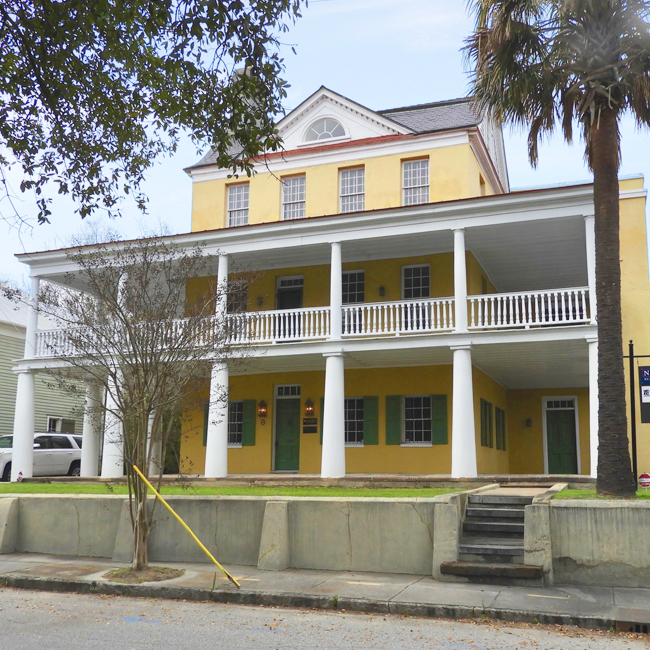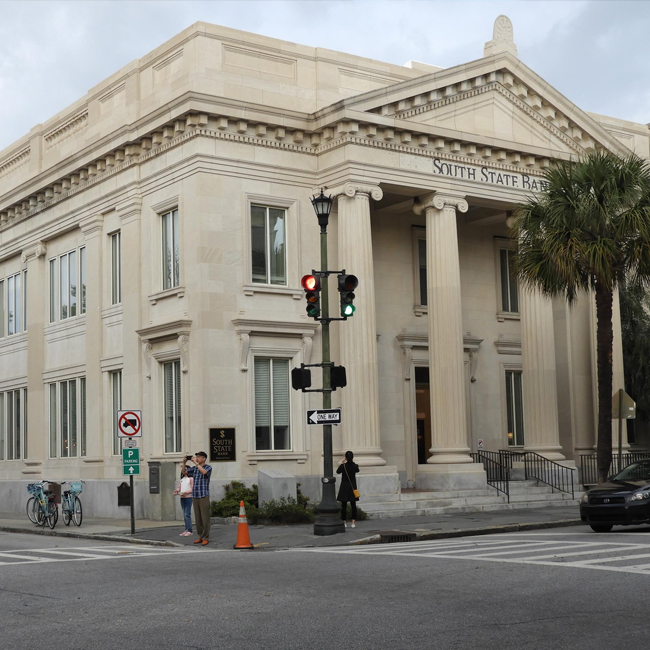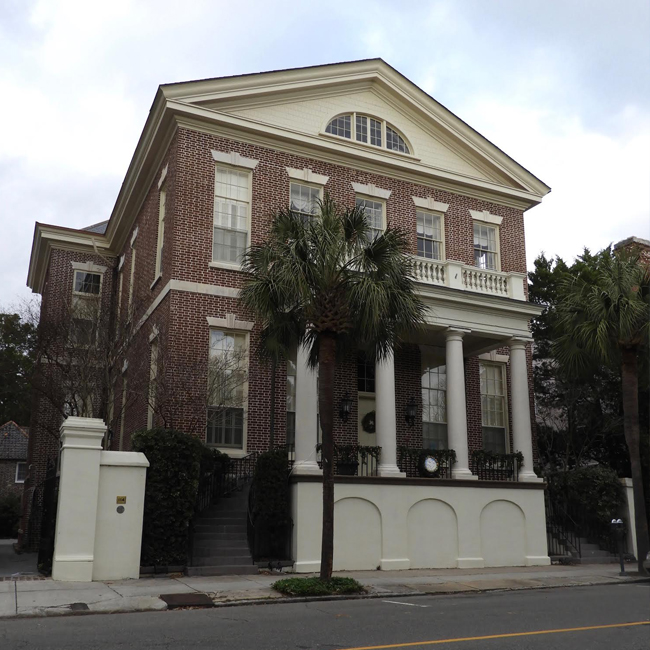What most people notice first about 95 Broad Street is its fabulous color -- that of a red-orange poppy. The paint seems to breathe instead of looking flat and uniform because the house has been "limewashed," an old European method of painting where lime is mixed with earth pigments for color. The paint works particularly well over absorbent surfaces such as stucco and brick. The effect particularly appeals to me as an artist.
Returning to Bull Street, we stop at 125 Bull, an Italianate-style building built after the Civil War. Still an imposing building and topped by a cupola, 125 Bull Street was completed by 1868 as Avery Normal Institute, an institution integral to the much later Civil Rights movement in South Carolina and beyond.
At the end of the Civil War, the Union kept soldiers in Charleston until 1880, primarily to ensure that the free blacks received fair treatment; 1865 to 1880 is known as the “Reconstruction Era”. Unfortunately, when the Union soldiers left, many whites reverted to old mindsets and prejudices and, in many ways attempted to “enslave” the free blacks again, only this time by using segregation and closed doors of opportunity.
This week, we travel to the other side of the Charleston peninsula as we visit 2 Amherst Street, located on the corner of East Bay and Amherst Streets, completed around 1808 and associated through the years with three old Charleston families. The house is a little different from other Charleston houses; 2 Amherst has a double piazza that crosses the front and then wraps part of the two sides of the house. Even from the exterior, this house exudes a charm of its own.
As founder and owner of the newspaper, Captain Dawson was involved in civic affairs, kept abreast of national and international news and communicated the same to his readers. He was a leader in the community and uniquely positioned to have a clear picture of the issues of the day, of which there were many. After the Civil War and during the Reconstruction era, the entire South was in a major, and frequently volatile, transition. Dawson used the paper, his "voice," to bring clarity to the situations surrounding Charleston and the South. I would imagine that Dawson was aware of the good, the bad, and the ugly in Charleston; it appears he did not hesitate to confront what came his way. That boldness led to his premature death.
This week we stay on Broad Street and travel west to visit 109 Broad. The lot was owned by Martin Campbell before the American Revolution, having been purchased in 1773. There is some confusion over the actual date of the house construction, probably pre-Revolutionary, perhaps 1776, or soon after the American Revolution around 1783. In any event, we know the house was standing by 1783.
This week we stay on Broad Street and travel west to visit 109 Broad. The lot was owned by Martin Campbell before the American Revolution, having been purchased in 1773. There is some confusion over the actual date of the house construction, probably pre-Revolutionary, perhaps 1776, or soon after the American Revolution around 1783. In any event, we know the house was standing by 1783.
This week we visit another original bank building at 50 Broad Street. This two-story building atop a raised basement was built in 1798 to house the Bank of South Carolina. Presently 50 Broad Street is no longer a bank, but has housed different businesses through its illustrious life.
Brick and marble are the prominent exterior features of 50 Broad and would seem to symbolize the solidity of the bank. Since Charleston has no stone, the imported white marble also symbolized the costliness of the building. The local brick, probably from the Boone Hall area, is laid out in a pattern known as the Flemish bond, where each row or "course" alternates a header, stretcher, header, stretcher, etc. More time and labor are required for this style of brickwork and thus Flemish bond is more expensive. It is also considered the most attractive of brickwork patterns.
This week we'll go back up Broad Street to 46 Broad where South State Bank is now located. This building is new by historic Charleston standards, having been constructed less than 100 years ago.
46 Broad was built as a bank in 1929, certainly not the most auspicious year for banking since the Great Crash (of the stock market) occurred in October of that year and ushered in the Great Depression. From its beginnings to the present, banking has remained the business of 46 Broad. Built by Olaf Otto, a civil engineer who also designed the Savannah River Bridge, this building stands out with its portico of fluted columns and ionic capitals.
This week we visit 119 Broad Street, across the street from last week's post on 114 Broad Street. The property was purchased by Morton Waring in 1803 and his house was completed by 1807. Waring had accumulated his wealth as a factor, or a middleman between seller and purchaser of crops and other goods ...
This week we visit 114 Broad Street, another Charleston house in the grand tradition, constructed of brick over a raised basement with a cascading staircase from each side of the portico. The construction was begun by Ralph Izard before 1800 but not completed until Colonel Thomas Pinckney purchased it in 1829. He and his wife, Eliza, the daughter of Ralph Izard, completed the house, hiring the Horlbeck brothers, builders of the Old Exchange Building, to finish construction. If you visit the Gibbes Museum of Art, make sure to see the miniatures in its collection of Thomas and Eliza Pinckney; they are an extremely attractive couple.
This week we visit the William Harvey House at 110 Broad Street. 110 Broad Street is one of our earlier structures, dating from 1728, and has been altered and renovated several times. Today this structure remains a single-family residence.
In addition to this early pre-Revolutionary house having escaped the 5 great fires of Charleston, the owners and inhabitants of 110 Broad are a fascinating part of the history of this city.
68 Broad Street is Charleston's oldest legacy house, completed by 1800. This brick single house replaced an earlier wooden residence that burned in the great fire of 1796. The original property was more extensive than it appears now, as it included the Washington Park property until that property was condemned and landscaped as the park.














